
- •Initializing with Constructor Functions . . . . .
- •Into a Web page as a separate section. Although JavaScript code can
- •Is that standard php script delimiters are guaranteed to be available
- •In the block. Any text or lines between the opening /* characters and
- •2.7541 Are not integers; they are floating-point numbers. A floating-
- •Value 300
- •Is a value of 2.5, because 6 goes into 15 exactly 2.5 times. But if you
- •IsEven.Php.
- •Ing example,
- •Ing curly brace is on its own line following the function statements.
- •In php 3 and earlier, it was necessary to put a function definition
- •Is called an iteration. When the conditional expression evaluates
- •Including Files
- •13. Close your Web browser window.
- •Including Files
- •In php, you can also use two operators to combine strings. The first
- •Xhtml source code gen-
- •Input. Php provides several functions for manipulating the case of a
- •Is uppercase. If you need the reverse of ucfirst(), the lcfirst()
- •In some situations, you will need to find and extract characters and
- •Information Interchange, or ascii, which are numeric represen-
- •In comparison, the following preg_match() function returns a value
- •In the pattern is optional. The following code demonstrates how to
- •Values; any strings you validate against a regular expression must
- •Value of 1 because the top-level domain contains a valid value of .Com.
- •Is submitted using the “post” method, the form data is embedded in
- •Validating String Data
- •Xhtml tags or character entities. The message field is a text string
- •Value of the header element. For example:
- •Xhtml code within a php script section.
- •Is typically the person who created the resource. Otherwise, the net-
- •If even a single character of the Web page is sent prior to sending
- •Variables to the file_put_contents() function.
- •Xhtml hyperlink. To download a file from outside the xhtml
- •If...Else statement to display the appropriate version of the mes-
- •Iterating Through an Array
- •Iterating Through an Array
- •In Chapter 2, you learned how to use a foreach statement to iterate
- •Iterating Through an Array
- •Iterating Through an Array
- •In comparison, the following code declares and initializes
- •If ((!file_exists("MessageBoard/messages.Txt"))
- •Values from the array to create a thumbnail gallery of images in which
- •Introduction to Databases
- •Including php, allow you to create Web pages that can read and write
- •Introduction to Databases
- •Information that can be organized into ordered sets of data, and
- •Information. Each recipe in a recipe database, for instance, is a single
- •Introduction to Databases
- •Index, which identifies records in a database to make retrievals and
- •In a single table. However, you might want to break the information
- •Into multiple tables to better organize it into logical sets. Another
- •Information in one of the tables confidential and accessible only by
- •Is the employee information table from Figure 7-1. The related table
- •Is a payroll table that contains confidential salary and compensation
- •Information. Notice that each table contains an identical number of
- •Introduction to Databases
- •Introduction to Databases
- •In a junction
- •Introduction to Databases
- •In a relational format is called a relational database management
- •Is a standard data manipulation language among many dbmSs.
- •Into the query area at the top of the screen or by dragging tables and
- •It is important to understand that even though many dbmSs sup-
- •Introduction to Databases
- •If you ever
- •Is. In comparison, the bigint data type stores integer values between
- •5 Rows in set (0.00 sec)
- •Int);[enter ]
- •Important, these two tabs can cause you to lose all of the data in the
- •Internet Explorer to export the table, click the Save button in the File
- •Ifies the table being changed and the change to make.
- •It easier for you to write php code that can be used with a variety of
- •Information about queries that match one of the following formats:
- •Various types of actions, depending on the type of query.
- •Include fields for the date and time of the flight, flight number, and
- •In the ChineseZodiac folder and upload the file to the server. Open
- •Including white space,
- •Information on a Web server. When you start a new session, the
- •Introduction to Object-Oriented Programming
- •Introduction to Object-Oriented
- •Variables associated with an object are called properties or attributes.
- •In the Loan object example, a function that calculates the number of
- •Introduction to Object-Oriented Programming
- •Introduction to Object-Oriented Programming
- •Include instances of objects inherit the object’s functionality.
- •In this chapter, you will create the Web site for an online order form
- •In an online store application. The application includes information
- •Ity of building a working online store. Online store classes are very
- •Information and products. The OnlineStore class requires that store
- •Information is stored in a table containing six fields: storeId, name,
- •Information. Instead, the class simply uses session iDs to keep track
- •Variable and function as necessary, without bothering with all this
- •In a class
- •Is developed. Imagine what would happen if Microsoft distributed
- •Ing class is invalid because it does not include an access specifier:
- •If they will not be supported by future xhtml versions or are not
- •Xhtml standards. To review the guide of current w3c css specifi-
- •Information to remind yourself or others of what the code is doing. A
- •Xhtml document to the external style sheet. This link informa-
- •If you select Apache from the WampServer menu and select Service
- •Ing code uses the number_format() function to add comma separa-
- •In data that a user submits to a php script.
- •Value of “On” and the display_startup_errors directive is assigned
- •Instead. By looking at the source code, you could see that the value of
- •Ing engine can even help locate logic errors.
- •In Chapter 8, along with the equivalent mssql_* functions, where
- •Inline styles, 632
- •Xhtml, 620–635 (continued)
CHAPTER
1
Getting
Started with PHP
Arithmetic
Binary Operators
Table
1-3 lists the PHP binary arithmetic operators and their
descriptions.
Symbol
42
+
−
*
/
%
Operation
Addition
Subtraction
Multiplication
Division
Modulus
Description
Adds
two operands
Subtracts
the right operand from the left
operand
Multiplies
two operands
Divides
the left operand by the right operand
Divides
the left operand by the right operand
and
returns the remainder
Table
1-3
PHP
arithmetic binary operators
The
following code shows examples of expressions that include
arithmetic
binary operators. Figure 1-22 shows how the expressions
appear
in a Web browser.
//
ADDITION
$x
= 100;
$y
= 200;
$ReturnValue
= $x + $y; // $ReturnValue is assigned theValue 300
echo '<p>$ReturnValue after addition expression: ',
$ReturnValue, "</p>";
// SUBTRACTION
$x = 10;
$y = 7;
$ReturnValue = $x − $y; // $ReturnValue changes to 3
echo '<p>$ReturnValue after subtraction expression: ',
$ReturnValue, "</p>";
// MULTIPLICATION
$x = 2;
$y = 6;
$ReturnValue = $x * $y; // $ReturnValue changes to 12
echo '<p>$ReturnValue after multiplication expression: ',
$ReturnValue, "</p>";
// DIVISION
$x = 24;
$y = 3;
$ReturnValue = $x / $y; // $ReturnValue changes to 8
echo '<p>$ReturnValue after division expression: ',
$ReturnValue, "</p>";
// MODULUS
$x = 3;
$y = 2;
$ReturnValue = $x % $y; // $ReturnValue changes to 1
echo '<p>$ReturnValue after modulus expression: ',
$ReturnValue, "</p>";
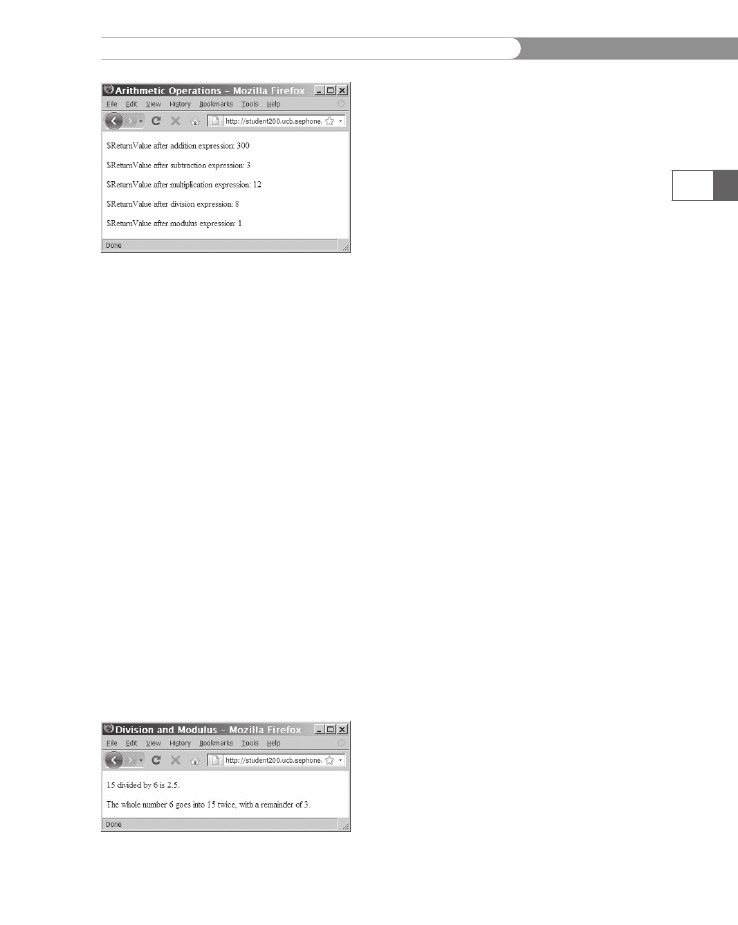
Building
Expressions
43
Figure
1-22
Results
of arithmetic expressions
Notice
in the preceding code that when PHP performs an arith-
metic
calculation, it performs the operation on the right side of the
assignment
operator and then assigns the value to a variable on the
left
side of the assignment operator. For example, in the statement
$ReturnValue
= $x + $y;,
the operands $x
and
$y
are
added, and
then
the result is assigned to the $ReturnValue
variable
on the left
side
of the assignment operator.
You
might be confused by the difference between the division (/)
operator
and the modulus (%)
operator. The division operator per-
forms
a standard mathematical division operation. In comparison,
the
modulus operator returns the remainder left from the division of
two
integers. The following code, for instance, uses the division and
modulus
operators to return the result of dividing 15 by 6. The result
express
this in whole numbers, 6 goes into 15 only 2 times, with a
remainder
of 3. Thus, the modulus of 15 divided by 6 is 3 because 3 is
the
remainder after the integer division. Figure 1-23 shows the output.
$DivisionResult
= 15 / 6;
$ModulusResult
= 15 % 6;
echo
"<p>15 divided by 6 is
$DivisionResult.</p>";
// displays '2.5'Is a value of 2.5, because 6 goes into 15 exactly 2.5 times. But if you
echo "The whole number 6 goes into 15 twice, with a
remainder of $ModulusResult.</p>"; // displays '3'
Figure 1-23
Division and modulus expressions

CHAPTER
1
Getting
Started with PHP
You
can include a combination of variables and literal values on the
right
side of an assignment statement. For example, any of the follow-
ing
addition statements are correct:
$ReturnValue
= 100 + $y;
$ReturnValue
= $x + 200;
$ReturnValue
= 100 + 200;
44
However,
you cannot include a literal value as the left operand of an
assignment
operator because the PHP scripting engine must have a
variable
to which to assign the returned value. Therefore, the state-
ment
100
= $x + $y; causes
an error.
When
performing arithmetic operations on string values, the PHP
scripting
engine attempts to convert the string values to numbers.
The
variables in the following example are assigned as string values
instead
of numbers because they are contained within quotation
marks.
Nevertheless, the PHP scripting engine correctly performs the
multiplication
operation and returns a value of 6.
$x
= "2";
$y
= "3";
$ReturnValue
= $x * $y; // the value of $ReturnValue is 6
Arithmetic
Unary Operators
Arithmetic
operations can also be performed on a single variable
using
unary operators. Table 1-4 lists the unary arithmetic operators
available
in PHP.
Symbol
++
−−
Operation
Increment
Decrement
Description
Increases
an operand by a value of 1
Decreases
an operand by a value of 1
Table
1-4
PHP
arithmetic unary operators
The
increment (++)
and decrement (−−)
unary operators can be used
as
prefix or postfix operators. A prefix operator is placed before a
variable.
A postfix operator is placed after a variable. The statements
++$MyVariable;
and
$MyVariable++;
both
increase $MyVariable
by
1. However, the two statements return different values. When you
use
the increment operator as a prefix operator, the value of the oper-
and
is increased by a value of 1 before it is returned. When you use
the
increment operator as a postfix operator, the value of the operand
is
increased by a value of 1 after it is returned. Similarly, when you
use
the
decrement operator as a prefix operator, the value of the operand
is
decreased by a value of 1 before it is returned, and when you use
Building
Expressions
the
decrement operator as a postfix operator, the value of the operand
is
decreased by a value of 1 after it is returned. If you intend to
assign
the
incremented or decremented value to another variable, it makes a
difference
whether you use the prefix or postfix operator.
You
use arithmetic unary operators in any situation in which you pre-
fer
a simplified expression for increasing or decreasing a value by 1.
For
example, the statement $Count
= $Count + 1; is
identical to the
statement
++$Count;.
As you can see, if your goal is only to increase
the
value of a variable by 1, it is easier to use the unary increment
operator.
For
an example of when you would use the prefix operator or the
postfix
operator, consider an integer variable named $StudentID
that
is used for assigning student IDs in a class registration script.
One
way of creating a new student ID number is to store the last
assigned
student ID in the $StudentID
variable.
When it’s time
to
assign a new student ID, the script could retrieve the last value
stored
in the $StudentID
variable
and then increase its value by
1.
In other words, the last value stored in the $StudentID
vari-
able
will be the next number used for a student ID number. In this
case,
you would use the postfix operator to increment the value
of
the expression after it is returned by using a statement similar
to
$CurStudentID
= $StudentID++;. If
you are storing the last
assigned
student ID in the $CurStudentID
variable,
you would want
to
increment the value by 1 and use the result as the next student ID.
In
this scenario, you would use the prefix operator, which increments
the
value of the expression before it is returned using a statement
similar
to $CurStudentID
= ++$StudentID;.
Figure
1-24 shows a simple script that uses the prefix increment oper-
ator
to assign three student IDs to a variable named $CurStudentID.
The
initial student ID is stored in the $StudentID
variable
and initial-
ized
to a starting value of 100. Figure 1-25 shows the output.
45
Figure
1-24
Script
that uses the prefix increment operator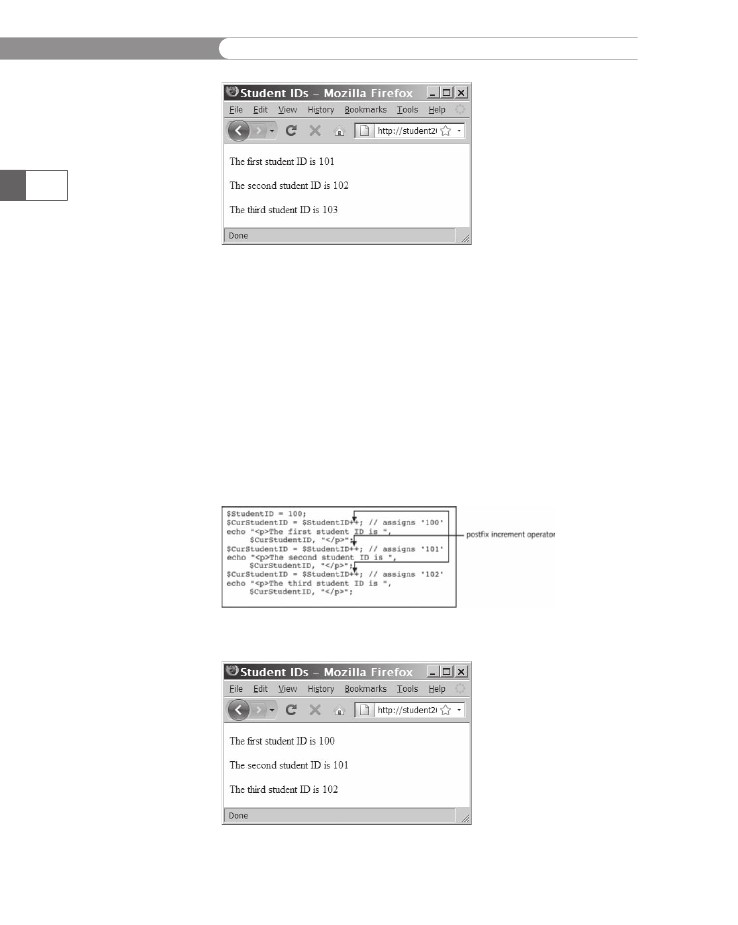
CHAPTER
1
Getting
Started with PHP
46
Figure
1-25 Output of the prefix version of the
student
ID script
The
script in Figure 1-26 performs the same tasks, but uses a postfix
increment
operator. Notice that the output in Figure 1-27 differs from
the
output in Figure 1-25. Because the first example of the script uses
the
prefix increment operator, which increments the $StudentID
variable
before it is assigned to $CurStudentID,
the
script does
not
use the starting value of 100. Rather, it first increments the
$StudentID
variable
and uses 101 as the first student ID. In compari-
son,
the second example of the script does use the initial value of 100
because
the postfix increment operator increments the $StudentID
variable
after it is assigned to the $CurStudentID
variable.
Figure
1-26
Script
that uses the postfix increment operator
Figure
1-27 Output of the postfix version of
the
student ID script
Building
Expressions
To
create a script that performs arithmetic calculations:
1.
2.
Create
a new document in your text editor.
Type
the <!DOCTYPE>
declaration,
<html>
element,
header
information,
and <body>
element.
Use the strict DTD and
“Arithmetic
Examples” as the content of the
Add the following standard PHP script delimiters to the docu-
ment body:
<?php
?>
47
3.
4.
Add the following statements to the script section to declare
two variables. These statements include a $Number variable
to contain a number, which you will use in several arithmetic
operations, and a $Result variable to contain the value of
each arithmetic operation.
$Number = 100;
$Result = 0;
5.
Now add the following statements that perform addition,
subtraction, multiplication, and division operations on the
$Number variable and assign each value to the $Result vari-
able. The $Result variable is displayed after each assignment
statement.
$Result = $Number + 50;
echo '<p>$Result after addition = ', $Result, "<br />";
$Result = $Number / 4;
echo '$Result after division = ', $Result, "<br />";
$Result = $Number − 25;
echo '$Result after subtraction = ', $Result, "<br />";
$Result = $Number * 2;
echo '$Result after multiplication = ', $Result,
"<br />";
6.
Next, add the following two statements. The first state-
ment uses the increment operator to increase the value of
the $Number variable by 1 and assigns the new value to the
$Result variable. The second statement displays the $Result
variable. Notice that the increment operator is used as a prefix
operator, so the new value is assigned to the $Result variable.
If you had used the postfix increment operator, the $Number
variable would have been incremented by 1 after the old value
of the $Number variable was assigned to the $Result variable.
$Result = ++$Number;
echo '$Result after increment = ', $Result, "</p>";
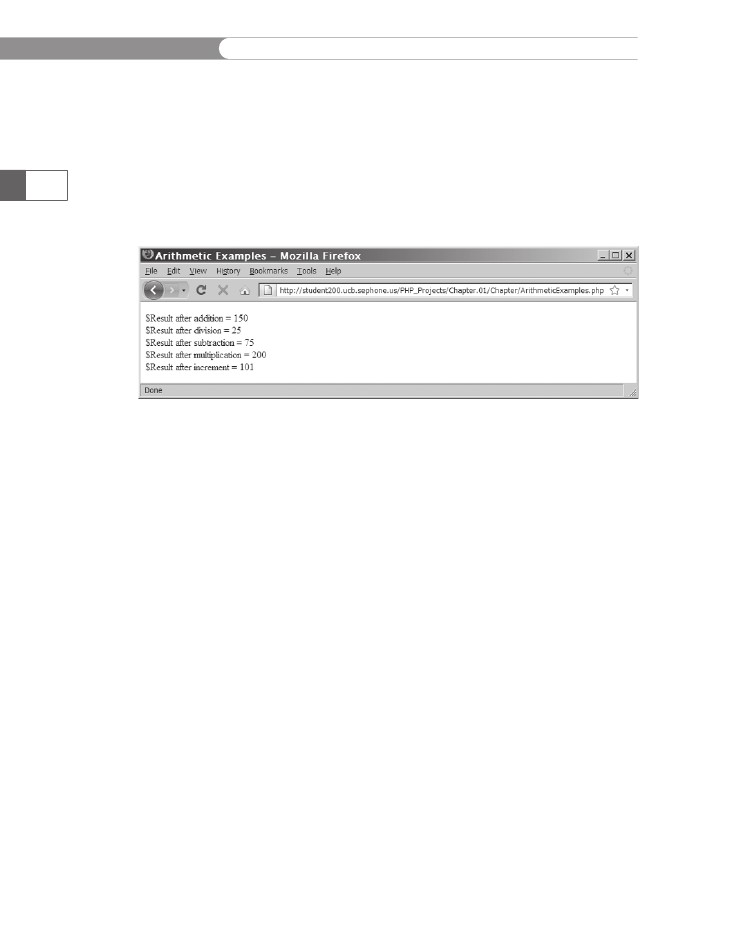
CHAPTER
1
Getting
Started with PHP
7.
Save
the document as ArithmeticExamples.php in the
Chapter
directory for Chapter 1, upload the document to the
Web
server, and then validate the document with the W3C
XHTML
Validator.
Open
the ArithmeticExamples.php file in your Web browser
by
entering the following URL: http://<yourserver>/PHP_
Projects/Chapter.01/Chapter/ArithmeticExamples.php.
Figure
1-28 shows the output.
8.
48
Figure
1-28
Output
of ArithmeticExamples.php
9.
Close
your Web browser window.
Assignment
Operators
Assignment
operators are used for assigning a value to a variable.
You
have already used the most common assignment operator, the
equal
sign (=),
to assign values to the variables that you declared. The
equal
sign assigns an initial value to a new variable or assigns a new
value
to an existing variable. For example, the following code creates a
variable
named $MyFavoriteSuperHero,
uses
the equal sign to assign
it
an initial value, and then uses the equal sign again to assign it a
new
value:
$MyFavoriteSuperHero
= "Superman";
$MyFavoriteSuperHero
= "Batman";
PHP
includes other assignment operators in addition to the equal
sign.
These additional operators, called compound assignment
operators,
perform mathematical calculations on variables and lit-
eral
values in an expression and then assign a new value to the left
operand.
Table 1-5 displays a list of the common PHP assignment
operators.
Building
Expressions
Symbol
Operation
=
+=
Description
Assigns
the value of the right operand to the left operand
Adds
the value of the right operand to the value of the left
operand
and assigns the new value to the left operand
Subtracts
the value of the right operand from the value of the left
operand
and assigns the new value to the left operand
Multiplies
the value of the right operand by the value of the left
operand
and assigns the new value to the left operand
Divides
the value of the left operand by the value of the right
operand
and assigns the new value to the left operand
Divides
the value of the left operand by the value of the right
operand
and assigns the remainder (modulus) to the left operand
49
Assignment
Compound
addition
assignment
Compound
subtraction
assignment
Compound
multiplication
assignment
Compound
division
assignment
Compound
modulus
assignment
−=
*=
/=
%=
Table 1-5
Common PHP assignment operators
The following code shows examples of the different assignment oper-
ators. Figure 1-29 shows the output.
echo "<p>";
$x = 100;
$y = 200;
$x += $y; // $x changes
echo $x, "<br />";
$x = 10;
$y = 7;
$x −= $y; // $x changes
echo $x, "<br />";
$x = 2;
$y = 6;
$x *= $y; // $x changes
echo $x, "<br />";
$x = 24;
$y = 3;
$x /= $y; // $x changes
echo $x, "<br />";
$x = 3;
$y = 2;
$x %= $y; // $x changes
echo $x, "<br />";
$x = "100";
$y = 5;
$x *= $y; // $x changes
echo $x, "</p>";
to 300
to 3
to 12
to 8
to 1
to 500

CHAPTER
1
Getting
Started with PHP
50
Figure
1-29
Assignment
operators
To
create a script that uses assignment operators:
1.
2.
Create
a new document in your text editor.
Type
the <!DOCTYPE>
declaration,
<html>
element,
header
information,
and <body>
element.
Use the strict DTD and
“Assignment
Examples” as the content of the
Add the following standard PHP script delimiters to the
document body:
<?php
?>
3.
4.
Type the following statements in the script section. These
statements perform several compound assignment operations
on a variable named $ChangingVar. After each assignment
operation, the result is displayed.
$ChangingVar = 100;
$ChangingVar += 50;
echo "<p>";
echo "Variable after
$ChangingVar<br />";
$ChangingVar −= 30;
echo "Variable after
$ChangingVar<br />";
$ChangingVar /= 3;
echo "Variable after
$ChangingVar<br />";
$ChangingVar *= 8;
echo "Variable after
$ChangingVar<br />";
$ChangingVar %= 300;
echo "Variable after
$ChangingVar</p>";
addition assignment =
subtraction assignment =
division assignment =
multiplication assignment =
modulus assignment =
5.
Save the document as AssignmentExamples.php in the
Chapter directory for Chapter 1, upload the document to the
Web server, and then validate the document with the W3C
XHTML Validator.
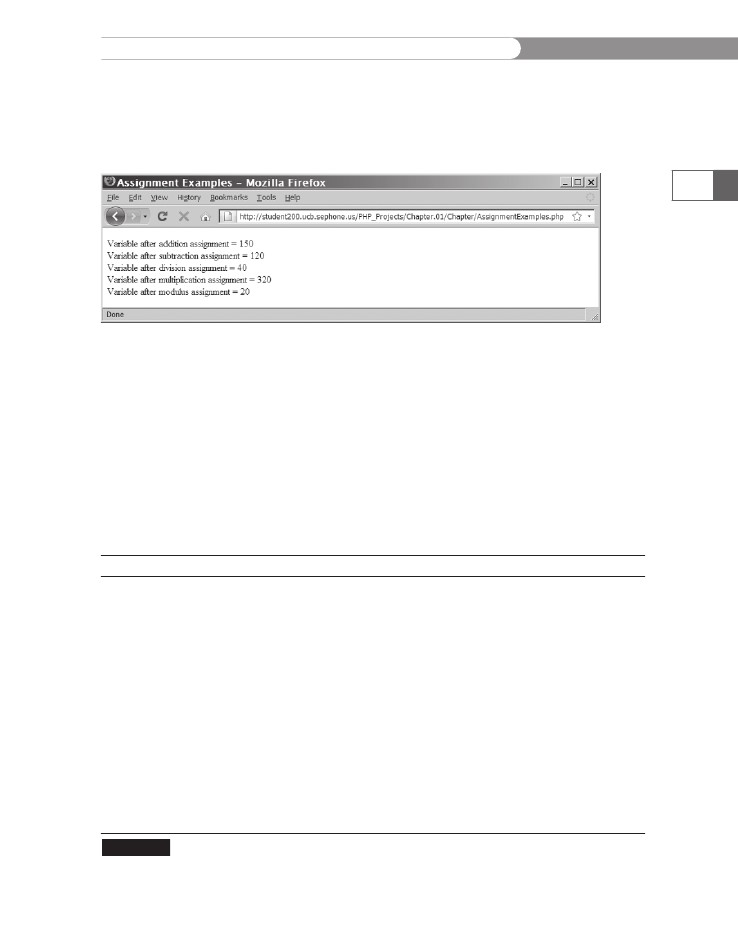
Building
Expressions
6.
Open
the AssignmentExamples.php file in your Web
browser
by entering the following URL: http://<yourserver>/
PHP_Projects/Chapter.01/Chapter/AssignmentExamples.php.
Figure
1-30 shows the output.
51
Figure
1-30
Output
of AssignmentExamples.php
7.
Close the Web browser window.
Comparison
and Conditional Operators
Comparison
operators are used to determine how one operand
compares
to another. A Boolean value of TRUE
or
FALSE
is
returned
after
two operands are compared. For example, the statement
5
< 3 returns
a Boolean value of FALSE
because
5 is not less than 3.
Table
1-6 lists the PHP comparison operators.
Symbol
==
===
!=
or
<>
!==
>
<
>=
<=
Operation
Equal
Strict
equal
Not
equal
Strict
not equal
Greater
than
Less
than
Greater
than or equal to
Less
than or equal to
Description
Returns
TRUE
if
the operands are equal
Returns
TRUE
if
the operands are equal and of the same data
type
Returns
TRUE
if
the operands are not equal
Returns
TRUE
if
the operands are not equal or not of the same
data
type
Returns
TRUE
if
the left operand is greater than the right
operand
Returns
TRUE
if
the left operand is less than the right operand
Returns
TRUE
if
the left operand is greater than or equal to
the
right operand
Returns
TRUE
if
the left operand is less than or equal to the
right
operand
Table
1-6
PHP
comparison operators
CHAPTER
1
The
comparison
operator ==
consists of
two equal
signs and
performs a different
function from the one
performed by the assign-
ment operator, which
consists of a single equal
sign (=). The comparison
operator compares
values, whereas the
assignment operator
assigns values.
Comparison
operators are
often used
with two
kinds of spe-
cial statements: condi-
tional statements and
looping statements. You
will learn how to use
comparison operators in
such statements in
Chapter 2.
Getting Started with PHP
52
You can use number or string values as operands with comparison
operators. When two numeric values are used as operands, the PHP
scripting engine compares them numerically. For example, the state-
ment $ReturnValue = 5 > 4; results in TRUE because the number
5 is numerically greater than the number 4. When two non-numeric
values are used as operands, the PHP scripting engine compares them
in alphabetical order. The statement $ReturnValue = "b" > "a";
returns TRUE because the letter b is alphabetically greater than
the letter a. When one operand is a number and the other is a
string, the PHP scripting engine attempts to convert the string
value to a number. If the string value cannot be converted to a
number, a value of FALSE is returned. For example, the statement
$ReturnValue = 10 == "ten"; returns a value of FALSE because the
PHP scripting engine cannot convert the string “ten” to a number.
However, the statement $ReturnValue = 10 == "10"; returns a
value of TRUE because the PHP scripting engine can convert the string
“10” to a number.
The comparison operator is often used with another kind of
operator, the conditional operator. The conditional operator
executes one of two expressions, based on the results of a con-
ditional expression. The syntax for the conditional operator is
conditional_expression ? expression1 : expression2;. If
conditional_expression evaluates to TRUE, expression1 executes.
If conditional_expression evaluates to FALSE, expression2
executes.
The following code shows an example of the conditional operator:
$BlackjackPlayer1 = 20;
($BlackjackPlayer1 <= 21) ? $Result =
"Player 1 is still in the game." : $Result =
"Player 1 is out of the action.";
echo "<p>", $Result, "</p>";
In the example, the conditional expression checks to see if
the $BlackjackPlayer1 variable is less than or equal to 21. If
$BlackjackPlayer1 is less than or equal to 21, the text “Player
1 is still in the game” is assigned to the $Result variable. If
$BlackjackPlayer1 is greater than 21, the text “Player 1 is
out of the action” is assigned to the $Result variable. Because
$BlackjackPlayer1 is equal to 20, the conditional statement returns
a value of TRUE, the first expression executes, and “Player 1 is still in
the game” appears on the screen. Figure 1-31 shows the output.

Building
Expressions
53
Figure
1-31
Output
of a script with a conditional operator
To
create a script that uses comparison and conditional operators:
1.
2.
Create
a new document in your text editor.
Type
the <!DOCTYPE>
declaration,
<html>
element,
header
information,
and <body>
element.
Use the strict DTD and
“Comparison
Examples” as the content of the
element.
Add the following standard PHP script delimiters to the docu-
ment body:
<?php
?>
3.
4.
Add the following statements to the script section to perform
various comparison operations on two variables. Notice that
the comparison statements use the conditional operator to
assign a text value of TRUE or FALSE to the $ReturnValue
variable.
$Value1 = "first text string";
$Value2 = "second text string";
$ReturnValue = ($Value1 == $Value2 ? "true" :
"false");
echo '<p>$Value1 equal to $Value2: ', $ReturnValue,
"<br />";
$Value1 = 50;
$Value2 = 75;
$ReturnValue = ($Value1 == $Value2 ? "true" :
"false");
echo '$Value1 equal to $Value2: ', $ReturnValue,
"<br />";
$ReturnValue = ($Value1 != $Value2 ? "true" :
"false");
echo '$Value1 not equal to $Value2: ', $ReturnValue,
"<br />";
$ReturnValue = ($Value1 <> $Value2 ? "true" :
"false");
echo '$Value1 not equal to $Value2: ', $ReturnValue,
"<br />";
$ReturnValue = ($Value1 > $Value2 ? "true" :
"false");
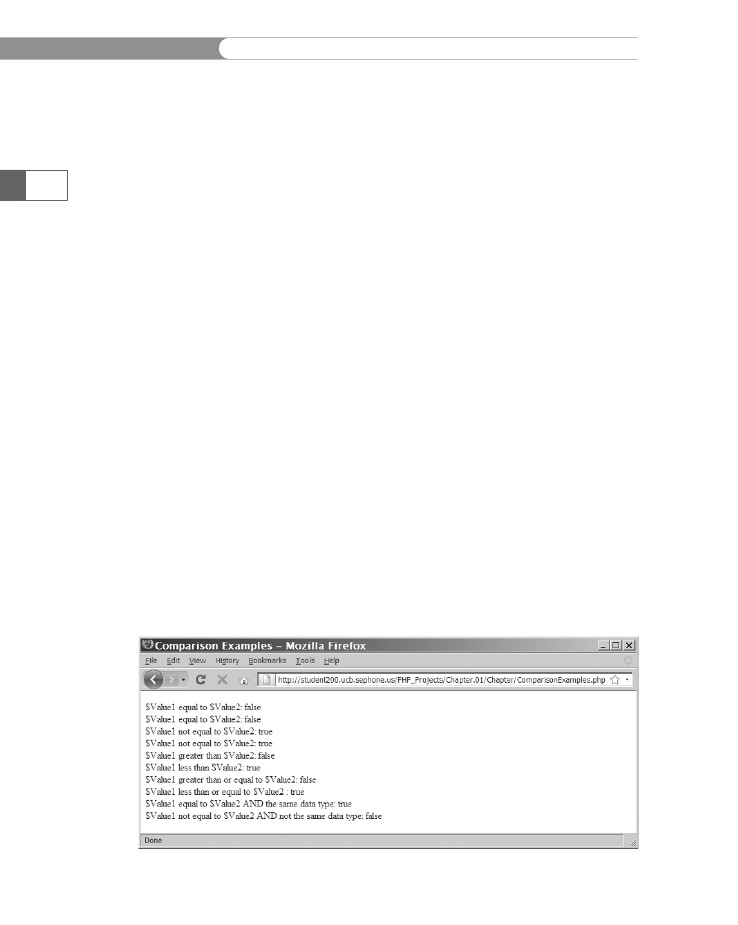
CHAPTER
1
Getting
Started with PHP
echo
'$Value1 greater than $Value2: ', $ReturnValue,
"<br
/>";
$ReturnValue
= ($Value1 < $Value2 ? "true" :
"false");
echo
'$Value1 less than $Value2: ', $ReturnValue,
"<br
/>";
$ReturnValue
= ($Value1 >= $Value2 ? "true" :
"false");
echo
'$Value1 greater than or equal to $Value2: ',
$ReturnValue,
"<br />";
$ReturnValue
= ($Value1 <= $Value2 ? "true" :
"false");
echo
'$Value1 less than or equal to $Value2 : ',
$ReturnValue,
"<br />";
$Value1
= 25;
$Value2
= 25;
$ReturnValue
= ($Value1 === $Value2 ? "true" :
"false");
echo
'$Value1 equal to $Value2 AND the same data
type:
',
$ReturnValue,
"<br />";
$ReturnValue
= ($Value1 !== $Value2 ? "true" :
"false");
echo
'$Value1 not equal to $Value2 AND not the same
data
type: ',
$ReturnValue,
"</p>";
54
5.
Save
the document as ComparisonExamples.php in the
Chapter
directory for Chapter 1, upload the document to the
Web
server, and then validate the document with the W3C
XHTML
Validator.
Open
the ComparisonExamples.php file in your Web
browser
by entering the following URL: http://<yourserver>/
PHP_Projects/Chapter.01/Chapter/ComparisonExamples.php.
Figure
1-32 shows the output.
6.
Figure
1-32
Output
of ComparisonExamples.php
Building
Expressions
7.
Close
your Web browser window.
Logical
Operators
Logical
operators are used for comparing two Boolean operands for
equality.
Boolean operands are operands that are limited to the val-
ues
TRUE
or
FALSE.
For
example, a script for an automobile insurance
company
might need to determine whether a customer is male and
under
21 to determine the correct insurance quote. As with compari-
son
operators, a Boolean value of TRUE
or
FALSE
is
returned after two
operands
are compared. Table 1-7 lists the PHP logical operators.
Symbol
&&
or
AND
55
Operation
Logical
And
Logical
Or
Description
Returns
TRUE
if
both the left operand and right operand return
a
value of TRUE;
otherwise,
it returns a value of FALSE
Returns
TRUE
if
either the left operand or right operand returns
a
value of TRUE;
otherwise
(neither operand returns a value of
TRUE),
it returns a value of FALSE
Returns
TRUE
if
only one of the left operand or right operand
returns
a value of TRUE;
otherwise (neither operand returns
a
value of TRUE
or
both operands return a value of TRUE),
it
returns
a value of FALSE
Returns
TRUE
if
an expression is FALSE
and
returns FALSE
if
an
expression is TRUE
||
or
OR
XOR
Logical
Exclusive Or
!
Logical
Not
PHP
logical operators
Table
1-7
For
the logical Or operator, you can use either ||
or
OR.
For the logi-
cal
And operator, you can use either &&
or
AND.
The logical Or, logi-
cal
Exclusive Or, and the logical And operators are binary operators
(requiring
two operands), whereas the logical Not (!)
operator is a
unary
operator (requiring a single operand). Logical operators are
often
used with comparison operators to evaluate expressions, allow-
ing
you to combine the results of several expressions into a single
statement.
For example, the logical And operator is used to determine
whether
two operands return an equivalent value. The operands
themselves
are often expressions. The following code uses the logical
And
(&&)
operator to compare two separate expressions:
$Gender
= "male";
$Age
= 17;
$RiskFactor
=
$Gender=="male"
&& $Age<=21; // returns TRUE
CHAPTER
1
Getting
Started with PHP
56
In
the preceding example, the $Gender
variable
expression evaluates
to
TRUE
because
it is equal to “male” and the $Age
variable
expression
evaluates
to TRUE
because
its value is less than or equal to 21. Because
both
expressions are TRUE,
$RiskFactor
is
assigned a value of TRUE.
The
statement containing the logical And operator (&&)
essentially
says,
“If variable $Gender
is
equal to ‘male’ and variable $Age
is
less
than
or equal to 21, then assign a value of TRUE
to
$RiskFactor.
Otherwise,
assign a value of FALSE
to
$RiskFactor.”
In the following
code,
however, $RiskFactor
is
assigned a value of FALSE
because
the
$Age
variable
expression does not evaluate to TRUE.
Notice
that the
following
code uses the AND
version
of the logical And operator.
$Gender
= "male";
$Age
= 28;
$RiskFactor
=
$Gender=="male"
AND $Age<=21; // returns FALSE
The logical Or operator checks to see if either expression evaluates
to TRUE. For example, the statement containing the logical Or opera-
tor (||) in the following code says, “If variable $SpeedingTicket is
greater than 0 or variable $Age is less than or equal to 21, then assign
a value of TRUE to $RiskFactor. Otherwise, assign a value of FALSE to
$RiskFactor.”
$SpeedingTicket = 2;
$Age = 28;
$RiskFactor =
$SpeedingTicket > 0 || $Age <= 21; // returns TRUE
The $RiskFactor variable in the preceding example is assigned a
value of TRUE because the $SpeedingTicket variable expression
evaluates to TRUE, even though the $Age variable expression evaluates
to FALSE. This result occurs because the logical Or operator returns
TRUE if either the left or right operand evaluates to TRUE. The follow-
ing example shows another version of the preceding code, but this
time using the OR version of the logical Or operator:
$SpeedingTicket = 2;
$Age = 28;
$RiskFactor =
$SpeedingTicket > 0 OR $Age <= 21; // returns TRUE
The following code is an example of the logical Not (!) operator,
which returns TRUE if an operand evaluates to FALSE and returns
FALSE if an operand evaluates to TRUE. Notice that because the logical
Not (!) operator is unary, it requires only a single operand.
$TrafficViolations = true;
$SafeDriverDiscount =
!$TrafficViolations; // returns FALSE
Building
Expressions
The
following code is an example of the logical Exclusive Or (XOR)
operator,
which returns TRUE
if
only one of the operands is TRUE,
but
not
both.
$RightSideSteering
= true;
$Country
= "England";
$IncorrectSteering
=
$RightSideSteering
== true
XOR $Country == "England"; // returns FALSE
To create a script that uses logical operators:
1.
2.
Create a new document in your text editor.
Type the <!DOCTYPE> declaration, <html> element, header
information, and <body> element. Use the strict DTD and
“Logical Examples” as the content of the
<title> element.Add the following standard PHP script delimiters to the docu-
ment body:
<?php
?>
Logical opera-
tors are often
used within
conditional
and looping
statements such as the
if . . . else, for,
and while statements.
You will learn about
conditional and looping
statements in Chapter 2.
57
3.
4.
Add the following statements to the script section that use
logical operators on two variables. The conditional expres-
sions evaluate the logical expressions and then assign a text
value of TRUE or FALSE to the $ReturnValue variable.
$TrueValue = true;
$FalseValue = false;
$ReturnValue = ($TrueValue ? "true" : "false");
echo "<p>$ReturnValue<br />";
$ReturnValue = ($FalseValue ? "true" : "false");
echo "$ReturnValue<br />";
$ReturnValue = ($TrueValue || $FalseValue ? "true" :
"false");
echo "$ReturnValue<br />";
$ReturnValue = ($TrueValue && $FalseValue ? "true" :
"false");
echo "$ReturnValue<br />";
echo "</p>";
5.
Save the document as LogicalExamples.php in the Chap-
ter directory for Chapter 1, upload the document to the
Web server, and then validate the document with the W3C
XHTML Validator.
Open the LogicalExamples.php file from your Web server by
entering the following URL: http://<yourserver>/PHP_Proj-
ects/Chapter.01/Chapter/LogicalExamples.php. Figure 1-33
shows the output.
6.
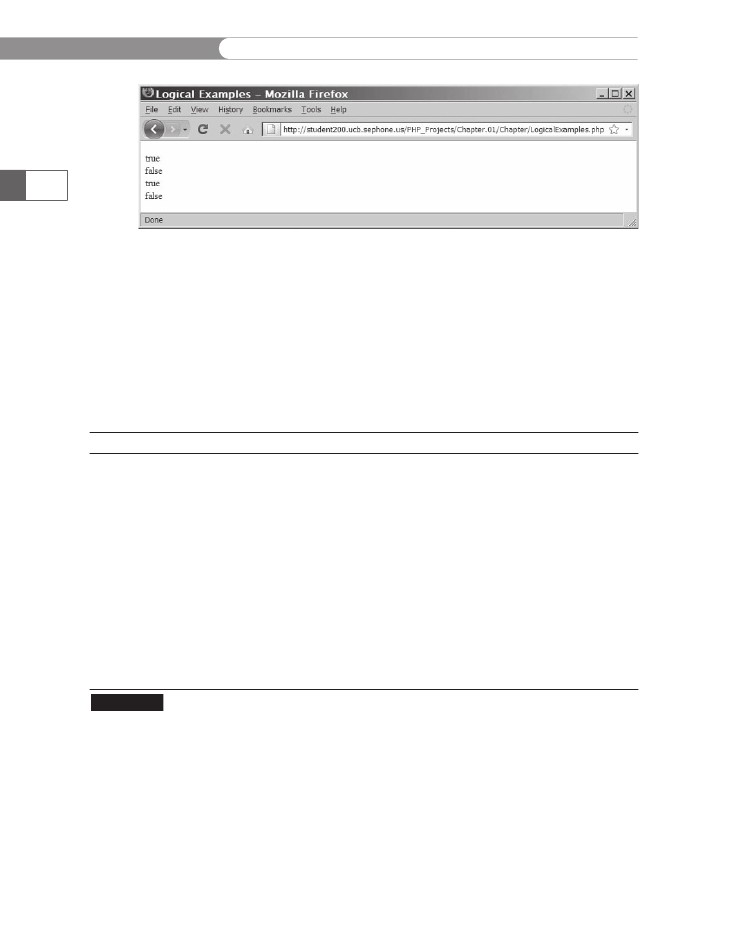
CHAPTER
1
Getting
Started with PHP
58
Figure
1-33
Output
of LogicalExamples.php
7.
Close the Web browser window.
Special
Operators
PHP
also includes the special operators that are listed in Table 1-8.
These
operators are used for various purposes and do not fit within
any
other category.
Symbol
[
and
]
=>
,
?
and
:
instanceof
@
(int),
(integer),
(bool),
(boolean),
(double),
(string),
(array),
(object)
Operation
Accesses
an element of an array
Specifies
the index or key of an array element
Separates
arguments in a list
Executes
one of two expressions based on the results of a
conditional
expression
Returns
TRUE if an object is of a specified object type
Suppresses
any errors that might be generated by an expression
to
which it is prepended (or placed before)
Casts
(or transforms) a variable of one data type into a variable of
another
data type
Table
1-8
PHP
special operators
You
will be introduced to the special PHP operators as necessary
throughout
this book, beginning with the casting operators in the
next
section.
Building
Expressions
Type
Casting
Even
though PHP automatically assigns the data type of a variable,
sometimes
you want to ensure that a variable is of the data type
expected
by your script. One way to ensure this is through casting,
or
type casting, which copies the value contained in a variable of
one
data type into a variable of another data type. The PHP syntax for
casting
variables is $NewVariable
= (new_type) $OldVariable;.
The
(new_type)
portion
of the syntax is the type-casting operator
representing
the type to which you want to cast the variable. Note
that
casting does not change the data type of the original variable.
Rather,
casting copies the data from the old variable, converts it to the
data
type specified by the type-casting operator, and then assigns the
value
to the new variable.
Type-casting
operators are useful because the data type of variables
can
change during the course of program execution. This can cause
problems
if you attempt to perform an arithmetic operation on a vari-
able
that happens to contain a string or the NULL
value.
For example,
the
first statement in the following code assigns a string value of “55
mph”
to a variable named $SpeedLimitMiles.
The second state-
ment
then multiplies the $SpeedLimitMiles
variable
by 1.6 to con-
vert
the value to kilometers. Notice that the second statement also
includes
the (int)
operator,
which converts the string value in the
$SpeedLimitMiles
variable
to an integer.
$SpeedLimitMiles
= "55 mph";
$SpeedLimitKilometers
= (int) $SpeedLimitMiles * 1.6;
echo
"$SpeedLimitMiles is equal to
$SpeedLimitKilometers
kph";
59
The third statement in the preceding code displays the text “55 mph
is equal to 88 kph” to the Web browser. The (int) operator con-
verted the string value of “55 mph” to an integer value of 55, which
was multiplied by 1.6 to calculate the kilometers. To be honest, the
PHP scripting engine would have performed the type cast automati-
cally, without the (int) operator. However, it doesn’t hurt to use type
casting to ensure that your variables are of the expected data type.
This is especially true if you need to perform operations on data that
is entered by users. As you will learn in Chapter 4, one of the most
common uses of PHP is to process form data that is submitted from
a client. You cannot be sure that a user will enter form data correctly,
so it’s a good idea for you to ensure that the data entered is of the type
expected by your script.
PHP can
convert a
string to a
numeric
value if the
string starts
with a numeric value. Any
subsequent non-numeric
characters are ignored.
You can also
perform a
type cast
with the
settype()
function.
CHAPTER
1
Getting
Started with PHP
Instead
of just guessing data types, you can view a variable’s type by
using
the gettype()
function,
which returns one of the following
strings,
depending on the data type:
•
Boolean
60
• Integer
• Double
• String
• Array
• Object
• Resource
• NULL
• Unknown type
You pass the name of a variable to the gettype() function as a
parameter using the syntax gettype($variable_name);. For
example, the first statement in the following code declares a double
variable named $MortgageRate (a double is a PHP floating-
point number). The second statement passes the name of the
$MortgageRate variable to the gettype() function. The value
returned from the gettype() function is then displayed by an echo
statement. The following code displays the text string “double” to the
screen.
$MortgageRate = .0575;
echo gettype($MortgageRate);
Although you can use the gettype() function to view a variable’s
data type, there are easier ways within PHP to determine if a variable
is of a specific data type. The best way is to use one of the 15 is_*()
functions that test for various kinds of data types. Each function
returns a Boolean value to indicate whether the variable is of a given
data type. For instance, the is_numeric() function tests whether
a variable contains a numeric data type, whereas the is_string()
function tests whether a variable contains a string data type. There
are also more specific is_*() functions, such as the is_int() func-
tion, which tests whether a variable is an integer data type, and the
is_double() function, which tests whether a variable is a double data
type. To use an is_*() function, you pass a variable name as an argu-
ment to the function you want to use. The following example uses
the is_double() function along with the conditional operator to test
the data type of the $MortgageRate variable. The conditional expres-
sion passes the $MortgageRate variable to the is_double() function,
and then determines whether the returned result is TRUE. Because

Building
Expressions
the
$MortgageRate
variable
is a double data type, a value of TRUE
is
returned
with the text “The variable contains a decimal number.”
$MortgageRate
= .0575;
$Result
= ((is_double($MortgageRate)) ?
"The
variable contains a decimal number." :
"The variable does not contain a decimal number.");
echo $Result;
61
The following example contains a modified version of the miles-to-
kilometers script. This time, a conditional operator uses the is_int()
function to determine whether the $SpeedLimitMiles variable is an
integer. If the variable is an integer, its value is simply multiplied by
1.6 and assigned to the $SpeedLimitKilometers variable. However,
if the variable is not an integer (in this case, it’s not), its value is cast
to an integer data type before being multiplied by 1.6 and assigned to
the $SpeedLimitKilometers variable.
$SpeedLimitMiles = "55 mph";
$SpeedLimitKilometers = ((is_int($SpeedLimitMiles)) ?
$SpeedLimitMiles * 1.6 :
(int) $SpeedLimitMiles * 1.6);
echo "$SpeedLimitMiles is equal to
$SpeedLimitKilometers kph";
Understanding Operator Precedence
When using operators to create expressions in PHP, you need to be
aware of the precedence of an operator. The term operator prece-
dence refers to the order in which operations in an expression are
evaluated. Table 1-9 shows the order of precedence for PHP opera-
tors. Operators in the same grouping in Table 1-9 have the same
order of precedence. When performing operations with operators in
the same precedence group, the order of precedence is determined by
the operators’ associativity—that is, the order in which operators of
equal precedence execute. Associativity is evaluated on a left-to-right
or a right-to-left basis.
Symbol
new clone
[]
++ −−
(int) (double) (string)
(array) (object)
@
Operator
New object—highest precedence
Array elements
Increment/Decrement
Cast
Suppress errors
Operator precedence in PHP (continues)
Associativity
None
Right to left
Right to left
Right to left
Right to left
Table 1-9

CHAPTER
1
(continued)
Symbol
instanceof
!
Getting
Started with PHP
Operator
Types
Logical
Not
Multiplication/division/modulus
Addition/subtraction/string
concatenation
Comparison
Equality
Logical
And
Logical
Or
Conditional
Assignment
Logical
And
Logical
Exclusive Or
Logical
Or
List
separator—lowest precedence
Operator
precedence in PHP
Associativity
None
Right
to left
Left
to right
Left
to right
None
None
Left
to right
Left
to right
Left
to right
Right
to left
Left
to right
Left
to right
Left
to right
Left
to right
62
*
/ %
+
− .
<
<= > >= <>
==
!= === !==
&&
||
?:
=
+= −= *= /= %= .=
AND
XOR
OR
,
Table
1-9
The
preced-
ing list in
Table 1-9
does not
include
bitwise operators.
Operators in a higher grouping have precedence over operators in
a lower grouping. For example, the multiplication operator (*) has
a higher precedence than the addition operator (+). Therefore, the
statement 5 + 2 * 8 evaluates as follows: The numbers 2 and 8 are
multiplied first for a total of 16, and then the number 5 is added,
resulting in a total of 21. If the addition operator had a higher prece-
dence than the multiplication operator, the statement would evaluate
to 56 because 5 would be added to 2 for a total of 7, which would then
be multiplied by 8.
As an example of how associativity is evaluated, consider the multi-
plication and division operators, which have an associativity of left
to right. This means that the statement 30 / 5 * 2 results in a value of
12—although the multiplication and division operators have equal
precedence, the division operation executes first due to the left-to-
right associativity of both operators. If the operators had right-to-
left associativity, the statement 30 / 5 * 2 would result in a value of 3
because the multiplication operation (5 * 2) would execute first. By
comparison, the assignment operator and compound assignment
operators, such as the compound multiplication assignment operator
(*=), have an associativity of right to left. Therefore, in the following
code, the assignment operations take place from right to left. The
variable $x is incremented by 1 before it is assigned to the $y variable

Summing
Up
using
the compound multiplication assignment operator (*=).
Then,
the
value of variable $y
is
assigned to variable $x.
The result assigned
to
both the $x
and
$y
variables
is 8.
$x
= 3;
$y
= 2;
$x
= $y *= ++$x;
63
You
can use parentheses with expressions to change the associativ-
ity
with which individual operations in an expression are evaluated.
For
example, the statement 5
+ 2 * 8,
which evaluates to 21, can be
rewritten
to (5
+ 2) * 8,
which evaluates to 56. The parentheses tell
the
PHP scripting engine to add the numbers 5 and 2 before multiply-
ing
by the number 8. Using parentheses forces the statement to evalu-
ate
to 56 instead of 21.
Short
Quiz
1.
What
symbol is used to divide the left operand by the right
operand
and return the remainder?
Explain
the difference between an assignment operator and a
compound
assignment operator.
Explain
the difference between a prefix operator and a postfix
operator.
Define
the term “associativity” as it applies to the order of
precedence.
2.
3.
4.
Summing
Up
•
JavaScript
and PHP are both referred to as embedded languages
because code for both languages is embedded within a Web page
(either an HTML or XHTML document).
• You write PHP scripts within code declaration blocks, which are
separate sections within a Web page that are interpreted by the
scripting engine.
• The individual lines of code that make up a PHP script are called
statements.

CHAPTER
1
Getting
Started with PHP
•
The
term “function” refers to a subroutine (or individual state-
ments grouped into a logical unit) that performs a specific task.
• Comments are nonexecuting lines that you place in code to con-
tain various types of remarks, including the name of the script,
your name and the date you created the program, notes to yourself,
or instructions to future programmers who might need to modify
your work. Comments do not appear in output or change the
functionality of the script.
• The values a program stores in computer memory are commonly
called variables.
• The name you assign to a variable is called an identifier.
• A constant contains information that cannot change during the
course of program execution.
• A data type is the specific category of information that a variable
contains.
• PHP is a loosely typed programming language.
• An integer is a positive or negative number or zero, with no deci-
mal places.
• A floating-point number contains decimal places or is written in
exponential notation.
• A Boolean value is a logical value of “true” or “false”.
• An array contains a set of data represented by a single variable name.
• An expression is a single literal value or variable, or a combination
of literal values, variables, operators, and other expressions, that
can be evaluated by the PHP scripting engine to produce a result.
• Operands are variables and literals contained in an expression. A
literal is a value such as a string or a number.
• Operators are symbols, such as the addition operator (
+) andmultiplication operator (*), used in expressions to manipulate
operands.
• A binary operator requires an operand before and after the
operator.
• A unary operator requires a single operand either before or after
the operator.
• Arithmetic operators are used in the PHP scripting engine to
perform mathematical calculations, such as addition, subtraction,
multiplication, and division.
64

Comprehension
Check
•
Assignment
operators are used for assigning a value to a variable.
• Comparison operators are used to determine how one operand
compares with another.
• The conditional operator executes one of two expressions, based
on the results of a conditional expression.
• Logical operators are used to perform operations on Boolean
operands.
• Casting or type casting creates an equivalent value in a specific
data type for a given value.
• Operator precedence is the order in which operations in an
expression are evaluated.
65
Comprehension Check
1.
What is the default extension that most Web servers use to
process PHP scripts?
a. .php
b. .html
c. .xhtml
d. .ini
2.
What do you use to separate multiple arguments that are
passed to a function?
a. a period (.)
b. a comma (,)
c. a forward slash (/)
d. a backward slash (\)
3.
You create line comments in PHP code by adding
to a line you want to use as a comment.
(Choose all that apply.)
a. ||
b. **
c. #
d. //

CHAPTER
1
Getting
Started with PHP
4.
Block
comments begin with /*
and
end with
a.
*/
b.
/*
c.
//
.
66
d.
**
5.
Which
of the following is a valid variable name?
a.
SalesOrder
b.
salesOrder
c.
$SalesOrder
d.
$1SalesOrder
6.
You
are not required to initialize a variable when you first
declare
it in PHP. True or False?
Which
is the correct syntax for declaring a variable and
assigning
it a string?
a.
$MyVariable
= "Hello";
b.
$MyVariable
= "Hello"
c.
"Hello"
= $MyVariable;
d.
$MyVariable
= Hello;
8.
9.
Explain
the concept of data types.
Explain
the purpose of the NULL
data
type.
.
7.
10.
A loosely typed programming language
a.
does not require data types of variables to be declared
b.
requires data types of variables to be declared
c.
does not have different data types
d.
does not have variables
11.
How many decimal places does an integer store?
a.
zero
b.
one
c.
two
d.
as many as necessary
Comprehension
Check
12.
Which of the following values can be assigned to a Boolean
variable?
(Choose all that apply.)
a. TRUE
b. FALSE
c. 1
d. YES
13. Which of the following refers to the first element in an
indexed array named
$Employees[]?a. $Employees[0]
b. $Employees[1]
c. $Employees[first]
d. $Employees[a]
14. The modulus operator (%)
.
67
a. converts an operand to base 16 (hexadecimal) format
b. returns the absolute value of an operand
c. calculates the percentage of one operand compared to
another
d. divides two operands and returns the remainder
15. What value is assigned to the $ReturnValue variable in the
statement
$ReturnValue = 100 != 200;?a. TRUE
b. FALSE
c. 100
d. 200
16. Which arithmetic operators can be used as both prefix and
postfix operators? (Choose all that apply.)
a. ++
b. −−
c. +
d. −

CHAPTER
1
Getting
Started with PHP
17.
The logical And (&&)
operator returns TRUE
if.
a.
the left operand returns a value of TRUE
b.
the right operand returns a value of TRUE
68
c.
the left operand and right operand both return a value
of
d. the left operand and right operand both return a value
of
FALSE18. What value is assigned to the $ReturnValue variable in the
statement
$ReturnValue = !$x;, assuming that $x has avalue of TRUE?
a. TRUE
b. FALSE
c. NULL
d. undefined
19. The order of priority in which operations in an expression are
evaluated is known as.
a. prerogative precedence
b. operator precedence
c. expression evaluation
d. priority evaluation
20. What is the value of the expression 4 * (2 + 3)?
a. 11
b. −11
c. 20
d. 14
Reinforcement Exercises
Exercise 1-1
In this project, you will create and modify a script that stores interest
rates in an array.
1.
Create a new document in your text editor.

Reinforcement
Exercises
2.
Type
the <!DOCTYPE>
declaration,
<html>
element,
header
information,
and <body>
element.
Use the strict DTD and
“Interest
Array” as the content of the
Add the following standard PHP script delimiters to the docu-
ment body:
<?php
?>
3.
69
4.
Add the following statements to the script section:
$InterestRate1
$InterestRate2
$InterestRate3
$InterestRate4
$InterestRate5
$InterestRate6
$InterestRate7
=
=
=
=
=
=
=
.0725;
.0750;
.0775;
.0800;
.0825;
.0850;
.0875;
5.
Using the array() construct, modify the statements you
added in the preceding step so the variables are saved in an
array named $RatesArray. Also, add statements to the pro-
gram that display the contents of each array element.
Save the document as InterestArray.php in the Projects
directory for Chapter 1, upload the document to the server,
and then validate it with the W3C XHTML Validator. After
the document is valid, open it in your Web browser to see
how it renders.
Close your Web browser window.
6.
7.
Exercise 1-2
What value is assigned to $ReturnValue for each of the following
expressions?
1.
2.
3.
4.
5.
6.
7.
$ReturnValue = 2 == 3;
$ReturnValue = "2" + "3";
$ReturnValue = 2 >= 3;
$ReturnValue = 2 <= 3;
$ReturnValue = 2 + 3;
$ReturnValue = (2 >= 3) && (2 > 3);
$ReturnValue = (2 >= 3) || (2 > 3);

CHAPTER
1
Getting
Started with PHP
Exercise
1-3
You
use the number_format()
function
when you want to for-
mat
the appearance of a number. The number_format()
function
adds
commas that separate thousands and determines the number
of
decimal places to display. You can pass two arguments to the
number_format()
function:
The first argument represents the literal
number
or variable you want to format, and the second argument
determines
the number of decimal places to display. If you exclude
the
second argument, the number is formatted without decimal
places.
In
this project, you will create a script that demonstrates how to use
the
number_format()
function.
1.
2.
Create
a new document in your text editor.
Type
the <!DOCTYPE>
declaration,
<html>
element,
header
information,
and <body>
element.
Use the strict DTD and
“Single
Family Home” as the content of the
Add the following standard PHP script delimiters to the docu-
ment body:
<?php
?>
70
3.
4.
Add the following statements to the script section. The
first statement assigns an integer value to a variable named
$SingleFamilyHome. The second statement then formats
the value in the $SingleFamilyHome variable and assigns the
formatted number to the $SingleFamilyHome_Print vari-
able. The number in the $SingleFamilyHome_Print variable
will include a comma that separates the thousands and will
include two decimal places. The final statement displays the
formatted number on the screen.
$SingleFamilyHome = 399500;
$SingleFamilyHome_Display =
number_format($SingleFamilyHome, 2);
echo "<p>The current median price of a single family
home in Pleasanton, CA is
$$SingleFamilyHome_Display.</p>";

